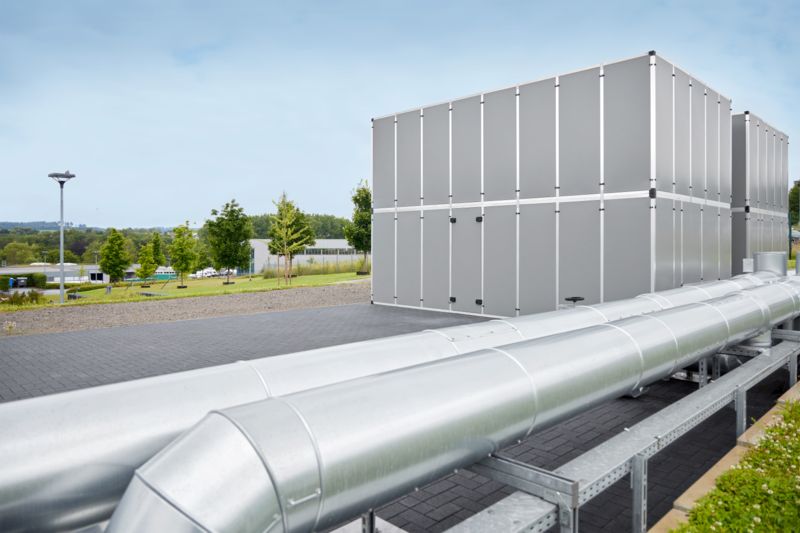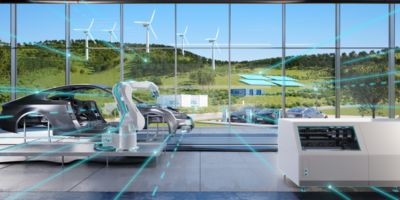Heat pumps for existing buildings Modernization at the brownfield site: natural gas reduced by 500,000 kWh per year resulting in a smaller carbon footprint.

Brief summary
What does it take to modernize existing buildings effectively in terms of energy efficiency? Well, not all that much as it happens. With the focus firmly on renewable energies, Phoenix Contact has equipped the first buildings at its headquarters in Blomberg with heat pumps as part of its decarbonization strategy.

While the first temperature stage was located outside the building, the plant room in the basement provided sufficient space for the second part of the system
Surface heating systems simplify retrofitting
The company invested around 600,000 euros in the sustainable upgrade, with the first step being to get two five-story multipurpose buildings off natural gas. This corresponds to around 500,000 kWh of thermal energy per year.
What were the basic requirements for the modernization of the brownfield site? An energy-efficient building envelope and a heating and cooling system that works with low flow-in temperatures thanks to underfloor or overhead heating. These are precisely the two features that are also familiar from the residential building sector when it comes to replacing aging oil or gas burners with electric ones.

If you measure your energy quantities accurately, there is a good chance that buildings may have sufficient reserves for alternative systems
A target/actual comparison is always worthwhile
From a technical point of view, heat pumps are cooling devices that work in reverse – similar to how a refrigerator works. The systems installed in Blomberg can supply both heating and cooling. “We want to be able to use the systems for cooling in the summer,” explains Stefan Gottschalk, Energy Manager at Phoenix Contact.
The actual thermal output required was determined in advance with the help of heat meters. The result was interesting. Stefan Gottschalk: “We wanted to know what we were actually consuming – and in the end we were well below the values calculated back when the buildings went into operation.” At the time, it was assumed that an output of 500 kW was required. However, the reality remained more economical at 350 to 400 kW.
Keeping the line cross-section in mind
It follows that the original building services were generously designed from a thermal point of view and therefore have reserves to keep the two buildings at an ideal temperature level for comfort. Stefan Gottschalk can therefore easily envisage connecting more buildings to the heat pumps, especially as the line system is also designed to transfer 500 kW.
From a general perspective, this correlation means that heat pumps can certainly supply lower temperatures in the flow without any loss of comfort if the transferred heat energy output can be balanced out with a higher volumetric flow. In this case, more water flows through the lines at a lower temperature.

The external heat pumps are placed in standardized containers
Moving away from oil and gas: Heating transition powered by electricity
Buildings 23 and 24, which were built a good ten years ago, mark the beginning of thermal decarbonization in Blomberg. The heat pumps installed in containers outside the two buildings still have plenty of capacity left to connect other buildings in the complex.
“Heat pumps are state of the art. So modernization is nothing to fear. What always needs to be clarified in advance for such measures is that the general conditions are right and that the existing heat transfer systems are suitable for the thermal design. HVAC planning offices can help here,” explains Stefan Gottschalk, encouraging people to take a closer look at this technology, which has been established for decades, for the benefit of the heating transition.
Connect with our experts

More posts

Integral building planning
How integral building planning and digitalization are revolutionizing building construction.

Coupling of factory and building
The Emalytics Automation building management system harmonizes data formats and intelligently networks sectors.

What is green hydrogen?
Green hydrogen is an energy carrier that is produced by the electrolysis of water, using only renewable energies.



